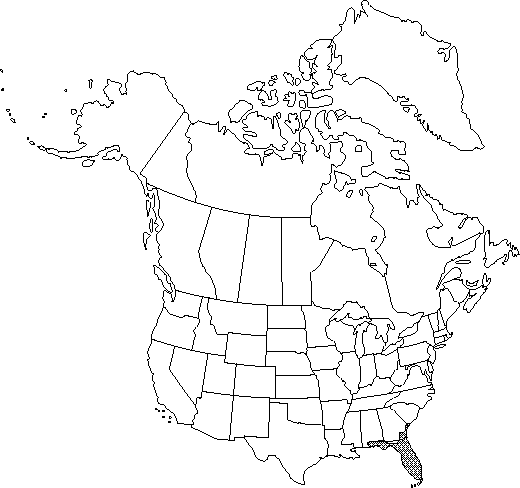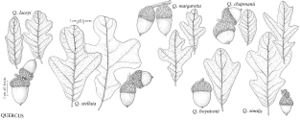Quercus chapmanii
Gard. & Forest 8: 93. 1895.
Shrubs, deciduous or subevergreen, 0.5-3(-6) m, often rhizomatous. Bark brown, scaly. Twigs yellowish, 1-2 mm diam., densely fine-tomentulose. Buds reddish brown, globose, 1-2(-3) mm, proximal scales densely tomentulose, distal scales glabrous. Leaves: petiole 1-3(-5) mm. Leaf blade obovate or oblanceolate, 30-70(-85) × 14-30(-45) mm, base cuneate or attenuate, margins minutely revolute, entire or sinuately lobed, sometimes obscurely 3-lobed distally or with 3-5 rounded, irregular lobes in distal 1/2, secondary veins curved, 8-9 on each side, apex ovate or triangular-lobed, often retuse; surfaces abaxially grayish or yellowish, with yellowish, erect branched hairs, these soon shed, leaving matted glandular and waxy hairs except on ± glabrate yellowish veins, adaxially bright glossy, very reflective, glabrous or with minute, scattered, stellate hairs. Acorns 1-2, on peduncle 1-6(-35) mm; cup hemispheric, 5-11 m deep × 10-15 mm wide, including 1/3-1/2 nut, scales closely appressed, gray, tomentulose; nut light brown, ovoid to barrel-shaped, 15-20 × 9-13 mm, apex rounded, glabrous or puberulent. Cotyledons distinct.
Phenology: Flowering late winter–early spring.
Habitat: Open pine forests, scrublands, xerophytic scrub oak, on sand near coast
Elevation: 0-100 m
Distribution

Fla., Ga., S.C.
Discussion
Selected References
None.
